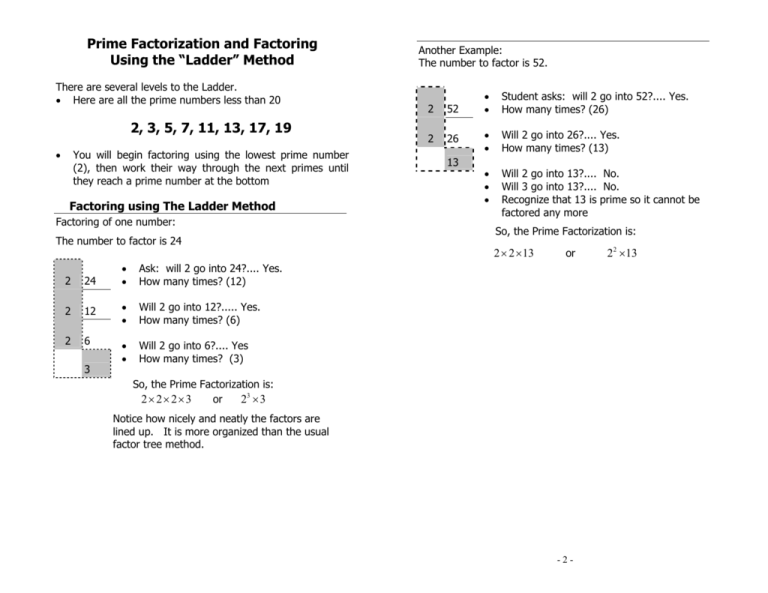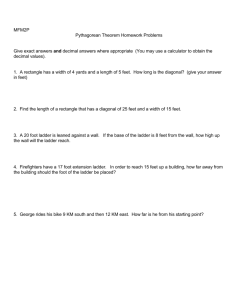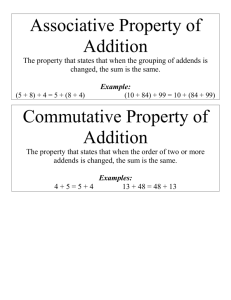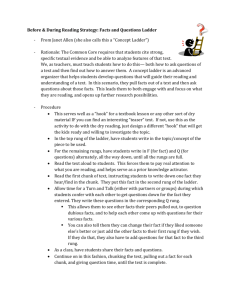The Ladder
advertisement

Prime Factorization and Factoring Using the “Ladder” Method There are several levels to the Ladder. • Here are all the prime numbers less than 20 2, 3, 5, 7, 11, 13, 17, 19 • You will begin factoring using the lowest prime number (2), then work their way through the next primes until they reach a prime number at the bottom Factoring using The Ladder Method Factoring of one number: The number to factor is 24 • • Ask: will 2 go into 24?.... Yes. How many times? (12) 12 • • Will 2 go into 12?..... Yes. How many times? (6) 6 • • Will 2 go into 6?.... Yes How many times? (3) 2 24 2 2 3 Another Example: The number to factor is 52. 2 52 2 26 13 • • Student asks: will 2 go into 52?.... Yes. How many times? (26) • • Will 2 go into 26?.... Yes. How many times? (13) • • • Will 2 go into 13?.... No. Will 3 go into 13?.... No. Recognize that 13 is prime so it cannot be factored any more So, the Prime Factorization is: 2 × 2 × 13 or So, the Prime Factorization is: 2× 2× 2×3 or 23 × 3 Notice how nicely and neatly the factors are lined up. It is more organized than the usual factor tree method. -2- 22 ×13 XMG Playbook © How to factor a numerator and a denominator for simplifying fractions: Use the Ladder to pull out the common prime factors. You can use the Ladder to find the Greatest common Factor(GCF) and the Least Common Multiple(LCM). The fraction to simplify is: • • 2 24 36 Make a “double Ladder” in order to factor out the common factor. First Label the numerator and the denominator. Ask: N D 24 36 • Will 2 go into 24 and 36?..... Yes. • How many times for each? • Will 2 go into 12 and 18?.... Yes. • How many times for each? 2 12 18 3 6 9 2/ 3 Finding the GCF and LCM Using the ladder you can find the Greatest Common Factor GCF and the Least Common Multiple LCM: GCF is 2 × 2 × 3 = 12 (Notice how these factors run along the side of the ladder and when multiplied, the result is the greatest common factor.) LCM is 2 × 2 × 3 × 2 × 3 = 72 (Notice how these factors form the shape of an “L” (for Ladder or LCM) and when multiplied, the result is the Least Common Multiple.) The fractions to add are: • • Will 2 go into 12 and 18?…. No. • Will 3 go into 12 and 18?…. Yes. • How many times for each? 3 In using the ladder, you pull out the common factors leaving the simplified form (numerator and denominator) on the bottom rung of the ladder. So, 24 2 = 36 3 As you “grow up” in factoring. You can take out a larger factor if you can recognize it. For example, on the first rung, if you saw that 6 was a factor of each number you could start with that number. Then you would have to factor 4 and 6 on the next rung. N 24 D 36 2 12 18 3 6 9 2 3 1 2 + 8 6 Make a “double Ladder” in order to factor out the least common multiple for the denominators Put the denominators into the ladder • Ask: 2 8 6 4 3 • • • • • Will 2 go into 8 and 6?..... Yes How many times for each? Will 2 go into 4 and 3?…. No Will 3 go into 4 and 3?…. No no more factoring can be done. Remember, the factors along the outside of the ladder make the Least Common Multiple when multiplied with each other. So, 2 x3 x 4= 24. The LCM is 24. Even better though is how this ladder method sets apart the factors for each denominator. The bottom rung leaves factors which are not common between the two denominators. Now, the student just has to multiply the two fractions by the missing factor for each denominator. Example: 1(3) 2(4) 3 8 + = + 8(3) 6(4) 24 24 3 nmcguire, 2005 2 -4- which is 11 24







